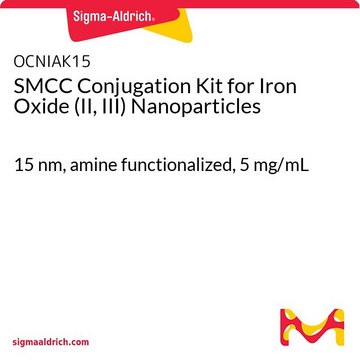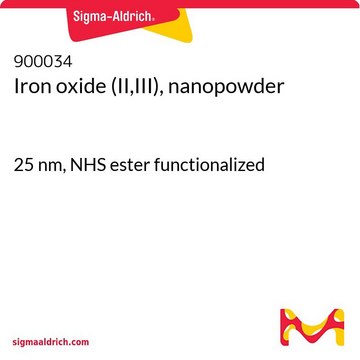747300
Iron oxide(II,III), magnetic nanoparticles solution
10 nm avg. part. size (TEM), amine functionalized, 1 mg/mL Fe in H2O, dispersion
Sinonimo/i:
Fe NP NH2, FexOy, Magnetic iron oxide nanocrystals, Magnetite, Superparamagnetic iron oxide nanoparticles
About This Item
Prodotti consigliati
Forma fisica
dispersion
nanoparticles
Livello qualitativo
Concentrazione
1 mg/mL Fe in H2O
Magnetizzazione
>45 emu/g (at room temperature; under 4500 Oe)
Colore
brown
Dimens. media delle particelle
10 nm (TEM)
Densità
0.997 g/mL at 25 °C
~1 g/mL at 25 °C
Gruppo funzionale
amine
Temperatura di conservazione
2-8°C
Stringa SMILE
O=[Fe].O=[Fe]O[Fe]=O
InChI
1S/3Fe.4O
SZVJSHCCFOBDDC-UHFFFAOYSA-N
Cerchi prodotti simili? Visita Guida al confronto tra prodotti
Descrizione generale
Applicazioni
Do not freeze.
Note legali
Codice della classe di stoccaggio
12 - Non Combustible Liquids
Classe di pericolosità dell'acqua (WGK)
WGK 2
Punto d’infiammabilità (°F)
Not applicable
Punto d’infiammabilità (°C)
Not applicable
Scegli una delle versioni più recenti:
Possiedi già questo prodotto?
I documenti relativi ai prodotti acquistati recentemente sono disponibili nell’Archivio dei documenti.
I clienti hanno visto anche
Articoli
Iron oxide (IO) nanoparticles consist of maghemite (γ-Fe2O3) and/or magnetite (Fe3O4) particles with diameters ranging from 1 and 100 nanometer and find applications in magnetic data storage, biosensing, drug-delivery etc.
Professor Yadong Yin (University of California Riverside, USA) examines both direct (thermal decomposition, solvothermal, hydrothermal) and indirect (templated) synthesis methods of magnetite nanocrystals and reviews in detail the landscape of these various synthetic methods for magnetite nanocrystal and their applications in magnetic assembly, magnetic hyperthermia, and Li-Ion batteries.
The recent emergence of a number of highly functional nanomaterials has enabled new approaches to the understanding, diagnosis, and treatment of cancer.
Biomaterials science involves the design and fabrication of smart materials for studying, directing, or mimicking biology. For successful integration of biomaterials in biological research, a meaningful understanding of biological systems is required.
Il team dei nostri ricercatori vanta grande esperienza in tutte le aree della ricerca quali Life Science, scienza dei materiali, sintesi chimica, cromatografia, discipline analitiche, ecc..
Contatta l'Assistenza Tecnica.



